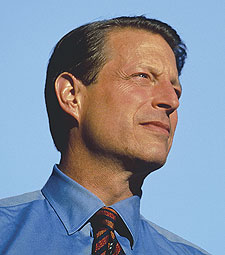Al Gore: One of the Most Powerful Vice Presidents
| Home |
| Family and Education |
| Political Career and Vice Presidency |
| Presidential Elections |
| Importance of Environment |
| Bibliography |
 |
Al Gore's political career is quite extensive. He actually received orders to go to Vietnam in 1970. His duty in Vietnam ended in June 1971, and he left the army. He received a personal honorable discharge a couple of months earlier in order to attend Vanderbilt University. In 1971, Al Gore began working as a reporter for "The Tennessean," a newspaper in Nashville, Tennessee. In 1984, Gore won election to the United States Senate. In 1987, Al Gore announced his candidacy for president of the United States. However, he decided not to run for presidency because he had some difficulties in his personal life. In April 1989, Al Gore's son was hit by a car and was badly injured. After the accident, Al Gore said "When you've seen your six-year old son fighting for his life, you realize that some things matter a lot more than winning." In 1992, the book "Earth in the Balance" was published and became a best-seller. In July 1992, Al Gore was chosen to be Bill Clinton's running mate: he was elected Vice President of the United States. In January 1993, Gore and Clinton were sworn into office. Clinton and Gore were re-elected in the 1996 election to a second term. Al Gore, America's 45th Vice President, has been one of the most powerful Vice Presidents in history. Al Gore has impressed Americans with his active role in our government. He has focused on issues such as the environment, technology and science, arms control and national security. Al Gore took tough measures to stop tobacco sales to children. He also asked television executives to increase children's programming on television. He also tried to connect the libraries and classrooms to the Internet. In addition, Al Gore insisted on special tax breaks in order to attract businesses to urban and rural areas. Al Gore's political career and Vice Presidency has moved America forward. |
 |
© Copyright 2007
All rights reserved. No part of this website may be reproduced or transmitted in any form or by means, electronic or mechanical, including photocopying, recording, or by any information storage or retrieval system.